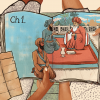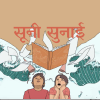The historic premises of the Mahesh Library on the present day Chitpur Road, despite its rich legacy, bears no signboard announcing its name or the date of its establishment. A casual visitor might pass it by, paying no attention to the elegant wooden panels that bear a wide variety of books, ranging from cookbooks to children’s primers, from religious pachalis to dusty jatra texts. Indeed, a glance at the bookstore might offer no insight into the fact that this publishing house once published pulp classics like the Deepak Chatterjee series by Swapan Kumar, and employed popular names like Narayan Debnath and Sailesh Pal for cover illustrations. Mahesh Chandra Gupta (Agarwal), the proprietor of Mahesh Library, has little interest in publicity. His children have moved into professions of their choice, and the business will almost certainly close down after he hands over the reigns. In his own words, 'I now run the business as a way of keeping fit.'
As one of the two remaining bookstores in the once bustling print market of the Chitpur-Garanhata area, better known as ‘Battala’ in the chronicles of print culture, Mahesh Library (formerly, General Library) stands as a vital link to an era gone by.
*
S.M.: The other day, you had mentioned that yours is a family business dating back to three generations. We would like to hear more about it.
M.G.: Yes, our business dates back three generations, that is to say, my grandfather, my father, and myself. My grandfather’s name was Ram Swarup Agarwal, but he used the name Ram Swarup Gupta for business because it sounds closer to a Bengali name. Our original surname, Agarwal, is a non-Bengali surname. My father, who was called, Krishna Chandra Agarwal, went by Krishna Chandra Gupta. I am Mahesh Chandra Agarwal, but I go by Mahesh Chandra Gupta. If you take a look at our older books, you will find the name Mahesh Chandra Gupta printed on the title page. Now we use Mahesh Publications instead.
Earlier, our organization was called General Library. Back then, this [their Chitpur premises] was our head office, and our branch office was located at Canning Street. Our business used to do quite well back then. At some point, I think around 1971, my father and his younger brother became embroiled in a dispute. The business was shut for nine long years. After settlement, my uncle was given the Canning Street office and my father was given this one [at Chitpur].
Back in those days, there were around 22-23 bookstores here in Chitpur. There was a proper book business here. It was called the Battala book market. My father, amidst all the dispute with his brother, started using these premises [at Chitpur] for business and also opened a stand of his own at College Street that he named Radha Pustakalaya. My uncle, meanwhile, opened his own bookstore at the Canning Street office that he named Rajendra Library. While my father handled the business in these premises, my brothers and I managed the College Street outlet. We used to print our books and covers according to the standards of the printing culture at the time. Afterwards, the three of us [Mahesh Gupta and his two brothers] requested our father to allow us the opportunity to work on something on our own. Hearing that, he told us that we could divide up his property as per our choice between the three of us. So my older brother chose the letterpress printing unit, my younger brother chose another unit, and I took what was left. That is to say, this business. I was granted ownership of this in 1981.
S.M.: Letterpress units must have been quite successful at the time. I suppose it is no longer feasible to run them.
M.G.: Yes, [letterpress machines] were used for printing back then. You see, the market back then also did not have a lot of competition—whatever we published, was sold. And besides, we would also send our books to other printing units in the market for printing, because our own printing press could not manage the volume of the books we published at that time.
Afterwards, my father told me to make a list of the unsold stock from General Library from the nine years that the business had been shut owing to the dispute between he and his brother. He told me that I could not have ownership of the Radha Pustakalaya books. So accordingly, I made a list and I chose books for myself from that unsold stock. But as it turned out, the market did not really appreciate those books… but there was nothing left to do, I had to clear the stock that I had received.
I have to say that I had benefited on one account during my tenure at Radha Pustakalaya. I met and came to be acquainted with a number of well-known printmakers and cover designers at the time. I got in touch with them again [after starting his own business]. Sailesh Pal, who used to handle mythological works, Narayan Debnath, famous for his comics, Satyen Chakrabarty, also very famous… a number of well-known print artists agreed to speak with me. I talked to them and then distributed work according to their respective areas of expertise. So after we reprinted the General Library books with new covers, we found that the market was beginning to accept them. I know the College Street market very well, so I made sure my books would be available there as well. And slowly, the market began to accept my books. But my books were supplied for the local market only. I have never supplied books for any other market. And one more thing, I realized that it is only after I redesigned the covers with artists of my choice and reprinted the books that the market truly opened up for these titles.
S.M.: I see.
M.G.: For instance, something like laminated covers. I don’t remember which year this was—it was a long time ago. My father used to do a lot of work for the share market. When the balance sheets came to our house, I would see that it was laminated on top. I didn’t know it was called lamination then. We used to call it varnish. The books are varnished, that’s what we said. But after observing closely, I realized that the balance sheets were not varnished, exactly. So I went to Calcutta and looked into the matter, and learned that this was called lamination. I started doing the same for the covers of my books. The market really accepted this. I don’t really hold any negative thoughts in my mind, so when people asked me about it, I told them how it was done. Now everyone uses laminated covers for their books.
S.M.: Oh, so it really became popular?
M.G.: Yes, nowadays you can’t imagine a book without a laminated cover.
S.M.: When was the General Library established?
M.G.: My grandfather started the General Library. I don’t remember the exact year. But in 1966, when I was in the 10th or 11th standard, I used to come and sit in the premises sometimes. The business had been started much earlier, probably around 1932. Almost at the same time as Diamond Library [established in 1931].
S.M.: So definitely long before Independence. How did your grandfather get into the business of printing Bengali books?
M.G.: Look, we never really asked that question. But from what I know, we were originally inhabitants of UP [Uttar Pradesh]. We used to live in UP. Then my grandfather came to Calcutta and set up a business of his own. There was a bookstore here called Sadharon Pustakalaya. The owners at the time were having trouble running the business, so they sold it to my grandfather who named it General Library.
S.M.: You said that there were a number of bookstores here earlier—
M.G.: Yes, around 22 to 23 shops.
S.M.: Really, 22-23 shops! So what happened to them? Could they not keep up with the business anymore?
M.G.: The reason they are no longer here is because the College Street market developed rapidly and a lot of bookstores opened there. It became easier for people to travel to College Street for books. It is well-connected to both Sealdah and Howrah [the two major railway stations]. The booksellers here therefore had to deal with a lot more competition. Some of them also closed their business because there was no one who could take up the reins. Some of them transferred to College Street. Some of them transferred to Canning Street.
S.M.: Do you have a store on Canning Street now?
M.G.: No, we don’t have an outlet on Canning Street. My uncle used to run a bookstore at Canning Street. After the passing of my uncle’s two sons, their wives took over. Canning Street sells different sorts of books. College Street, again, sells different books.
S.M.: That’s true, College Street usually sells fiction and textbooks. You seem to keep a lot of religious books in your store.
M.G.: Yes, I keep astrology books, cookbooks, then books based on mythology. I keep a variety of assorted other books as well. But I don’t keep any books from the [school or college] syllabus. Everything I sell here is out of syllabus. But I mostly keep this business running now because I feel like it.











